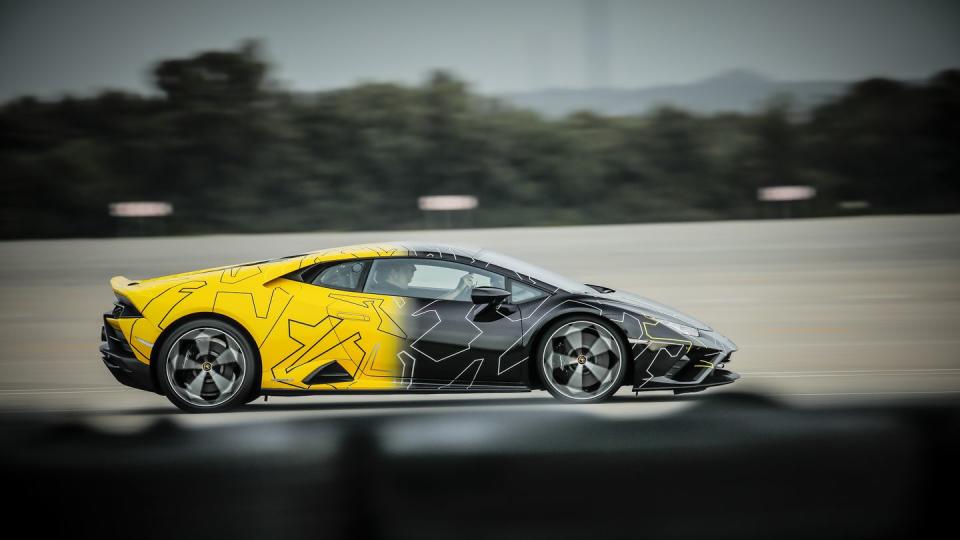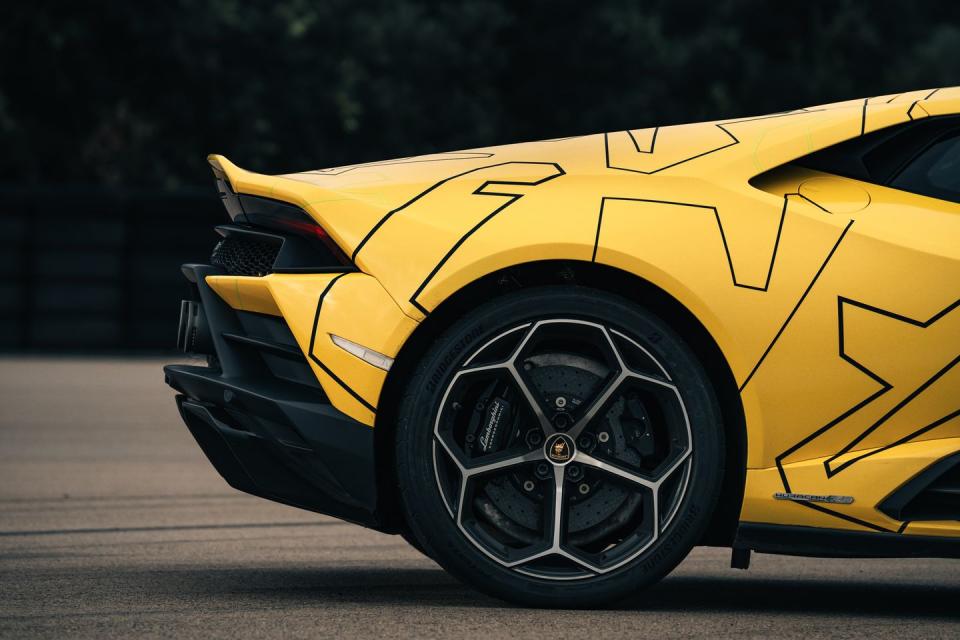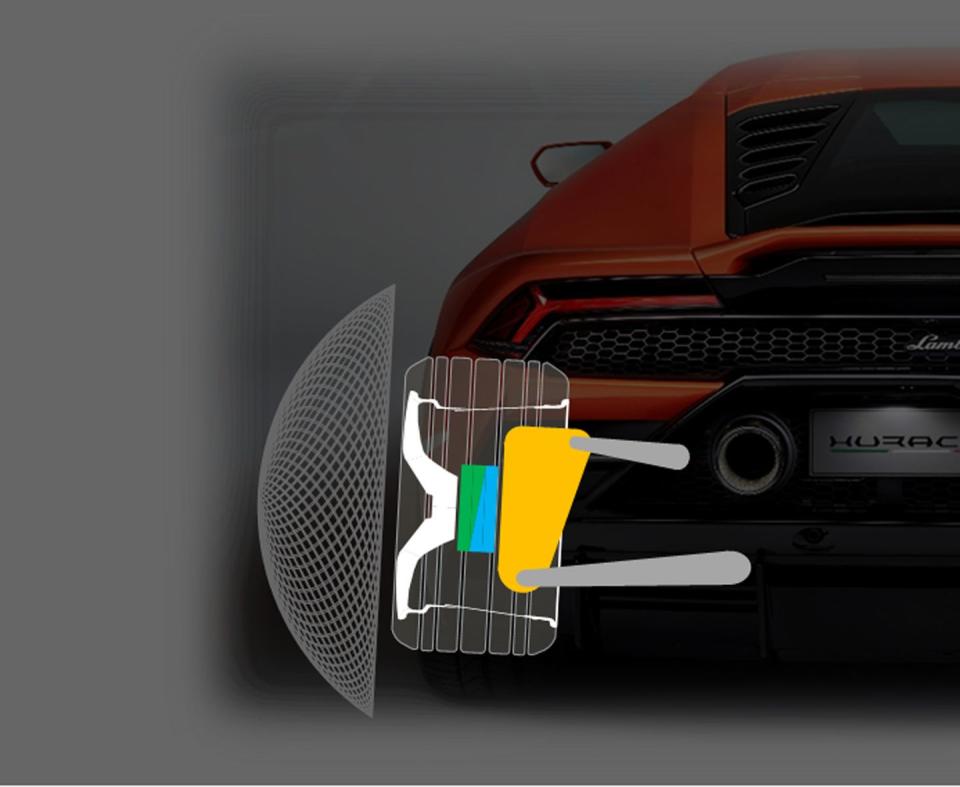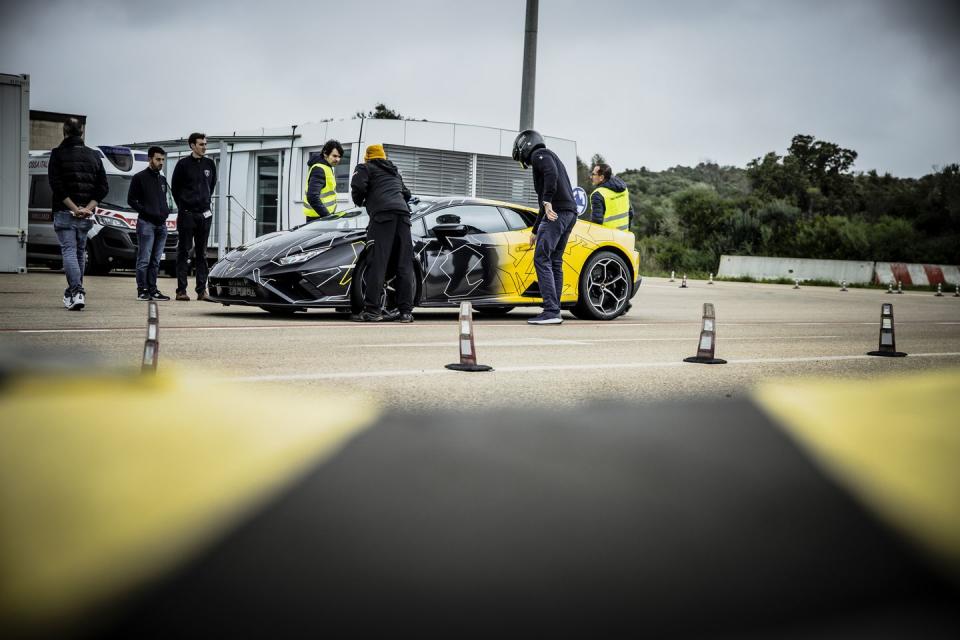Lamborghini Tests Active Camber and Toe Control for Better Handling

It's not often that we get to experience a new and completely novel piece of automotive technology for the first time. But that's what Lamborghini seems to have created with its Active Wheel Carrier, which we have now sampled in prototype form. The system itself is both clever and complex, but the basic purpose is simple: to give real-time control of camber and toe alignment settings while a car is moving.
According to Rouven Mohr, Lamborghini's chief technical officer, this is one of the final frontiers of vehicle dynamics. Suspension geometry is usually based around a set of compromises, with the loads created by a car in motion inevitably negatively affecting at least some of these. And the alignment settings that are right for the track will cause premature tire wear on the street, which is why many high-performance cars have track-alignment settings and necessitate switching back and forth. Gaining active control in two different planes—toe being the angle of the rotating wheel relative to the direction of travel, and camber its side-on angle relative to the ground—means that many of these compromises can be eliminated. The results, based on our drive in a Lamborghini Huracán development mule at Porsche's Nardò test track in Italy, are deeply impressive.
The idea itself is not new, and Mohr admits that work on it was being done at fellow VW sibling Audi when he previously worked there. But as well as the hardware required to move the wheel in two planes, the challenge is creating a control system capable of doing so quickly and accurately enough to allow the benefits to be exploited. This is an area in which Lamborghini is leading the way.
The system works exclusively on each of the Huracán prototype's rear wheels. Active toe control is, in essence, a rear-steering system. We've had those before, of course—but this one can also move the wheels between toe-in, where the leading edges point very slightly toward each other, and toe-out, where they do the opposite. In very general terms, toe-out makes a car more reactive and keener to turn, while toe-in gives better high-speed stability.
Active camber control is more revolutionary. Under cornering loads, a car leans over and the suspension compresses, which alters the relationship between the tire tread and the road surface. On something as low and firmly suspended as a Lamborghini supercar, the effect is much slighter than it would be on a 1970s sedan, but it is still significant, as it creates uneven pressure distribution on the tire's contact patch, which reduces grip. Many performance cars are set up with negative camber (the tire leaned in on its inside edge) to compensate for this, but doing so reduces straight-line traction and increases tire wear. The Active Wheel Carrier's ability to adjust it according to load is in effect a "have your cake and eat it too" solution, allowing the tire to generate up to 25 percent more cornering force, according to Lamborghini.
More Revolutionary Than It Looks
Viewed up close, the Active Wheel Carrier does not look like a revolutionary leap forward. It initially seems to be a large hub assembly, with one face to mate with the half-shaft connecting to the transmission and the other joining the hub that holds the wheel. But two rotating flanges within are what alter the relative angle between the two sides, one controlling camber and the other toe. These are gear-driven by 48-volt electric motors. The system is designed only for rear wheels; Lamborghini is already using twin-motor electric torque vectoring on the front wheels of the Revuelto, with this likely to also be used on the Huracán replacement.
The Active Wheel Carrier can deliver up to 6.6 degrees of toe adjustment in either direction and between 2.5 degrees of positive and 5.5 degrees of negative camber. Both planes can be adjusted at the same time, and the electric motors can do this at up to 60 degrees a second. So even the most extreme change possible—from full toe-in to full toe-out—could be accomplished in under a quarter of a second, although most changes will be much smaller adjustments.

According to Mohr, the hardware is the easy part here. Controlling the Active Wheel Carrier requires a hugely complex dynamic control system, one that will ultimately have to work in partnership with stability control, torque management, and active aero systems. But that's in the future; at the moment the prototype is running in a rear-driven Huracán Evo without any traction or stability control.
Driving the Active Wheel Carrier
Our drive took place at Porsche's vast Nardò proving ground in southern Italy, where we've piloted several new Lamborghinis for the first time (including the Revuelto, Urus Performante, Huracán Tecnica, and Huracán STO). Before hitting the 3.9-mile handling track, we got the chance to experience the difference the system makes on the enormous steering pad—several acres of asphalt that allows for safe experimentation.
Starting with the system switched off, and the Evo's rear suspension in its default position, reveals both understeer on cold tires when driven aggressively plus a rapid transition to oversteer when the rear grip is exceeded. With the Active Wheel Carrier switched on, the Huracán immediately feels more grippy and reactive, keener to change direction—much of which is due to the rear-steering effect of toe adjustment—but also much more stable when being pushed to the edge of adhesion.

Moving to the handling track gives the chance to drive back-to-back stints with the system off and then on. The Huracán is, as always, hugely fast, with the V-10 snarling as it devours the ratios of the seven-speed dual-clutch transmission. It was poignant to realize that this is one of the last times we'll get to experience one of the world's most charismatic engines in a new car; the Huracán replacement will be switching to a twin-turbo V-8.
But we haven't come to Nardò for the engine, rather the chassis. The first revelation on the handling track, when driving with the AWC switched off, is just how much work the Huracán's stability control ordinarily has to do under hard use. Without it, the Evo prototype picks up significant front-end push in tighter turns and feels skittish when asked to turn into quicker corners, particularly the fast left-hander at the end of Nardò's 0.6-mile-long main straight.
With Active Wheel Control activated, the difference is immediate and obvious. It feels as if the rear axle has gained significantly more grip. The prototype immediately finds more traction in slower corners, but it also feels much more stable at higher speeds and in faster turns. The actual changes being made by the system are slight, especially to camber. Talking to Mohr reveals alterations are normally only fractions of a degree, with multiple corrections each second. But the effects are profound, and with AWC working, this aged Huracán feels like a different car.

The biggest problem is one of overconfidence, as Mohr admits that drivers experiencing AWC for the first time often presume it is capable of correcting outright loss of control, which it isn't. But the system's effect can certainly be measured: On the handling track, our fastest lap with AWC on was 4.8 seconds faster than with the system off, and while that effect is reduced for more experienced drivers on more familiar tracks, it's still significant. Even a Lambo pro driver is reportedly 2.8 seconds quicker at Nardò with AWC. That's on par with the gain by switching from sport tires to street-legal semi-slicks.
The technology would also enable other changes: wider front tires relative to the rears, slightly softer springs to allow more roll (active camber being able to adjust to this), and the intriguing possibly of running different tire compounds front and rear to make maximum benefit from the improved grip. Motors powering the units would also likely be upgraded to work on 400 volts, supplied directly from the plug-in-hybrid battery pack.
While AWC is officially only an experiment at this stage, it seems overwhelmingly likely to play a part in Lamborghini's future—most likely the Huracán replacement that will debut next year.
You Might Also Like

 Yahoo Autos
Yahoo Autos 